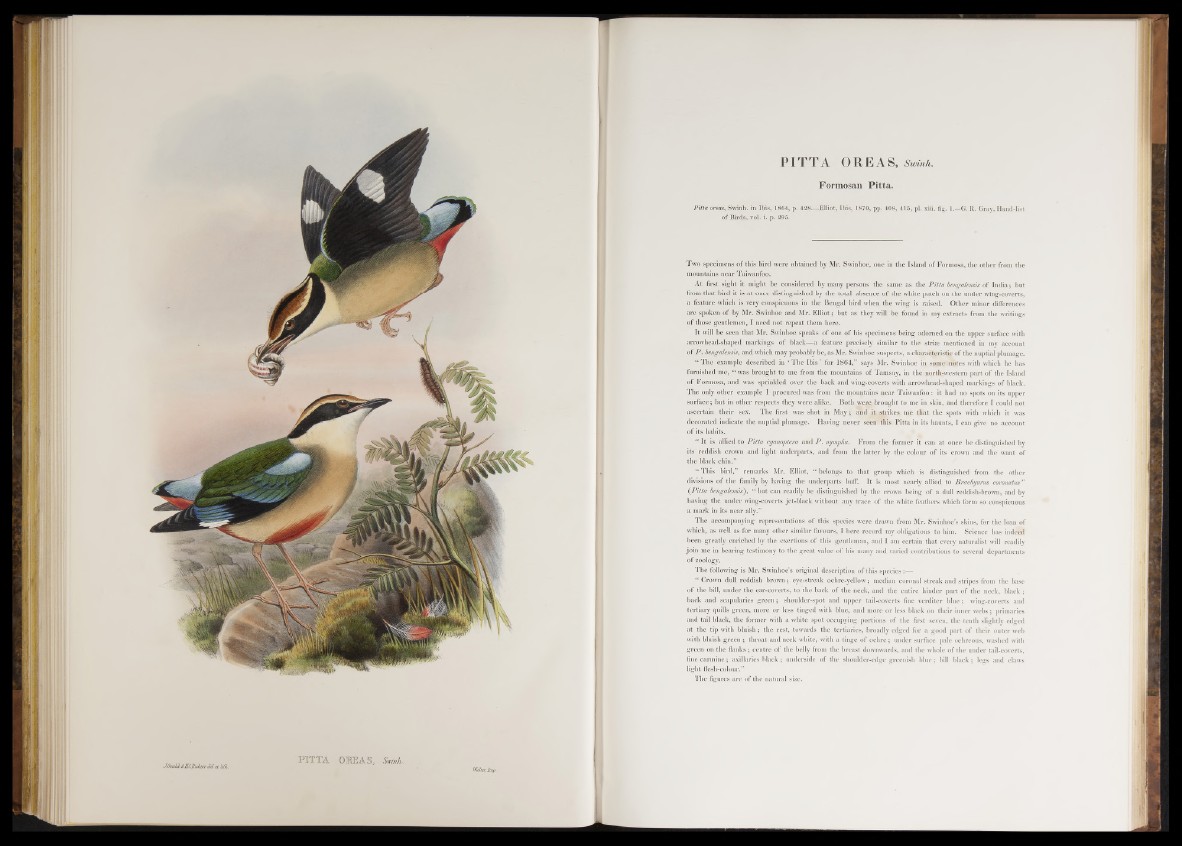
■ i , PITIA. 0EEAS, Srnnh. J.&ovM fr EC.lhchter Jrl d hth. . 1trl _ Waller, Im p.
PITTA OREAS, Sminh.
Formosan P itta .
Pitta oreas, Swinh. in Ibis, 1864, p. 428 Elliot, Ibis, 1870, pp. 408, 416, pi. xiii. fig. 1.—G. R. Gray, Hand-list
o f B irds, vol. i. p. 2.95.
Two specimens of this bird were obtained by Mr. Swinhoe, one in the Island of Formosa, the other from the
mountains near Taiwanfoo.
At first sight it might be considered by many persons the same as the Pitta bengalensis of In d ia; but
from that bird it is a t once distinguished by the total absence of the white patch on the under wing-coverts,
a feature which is very conspicuous in the Bengal bird when the wing is raised. Other minor differences
are spoken of by Mr. Swinhoe and Mr. Ellio t; but as they will be found in my extracts from the writings
of those gentlemen, I need not repeat them here.
I t will be seen that Mr. Swinhoe speaks of one o f his specimens being adorned on the upper surface with
arrowhead-shaped markings o f black—a feature precisely similar to the striae mentioned in my account
of P . bengalensis, and which may probably be, as Mr. Swinhoe suspects, a characteristic o f the nuptial plumage.
“ T he example described in ' The Ibis ’ for 1864,” says Mr. Swinhoe in some notes with which he has
furnished me, “ was brought to me from the mountains of Tamsuy, in the north-western part of the Island
of Formosa, and was sprinkled over the back and wing-coverts with arrowhead-shaped markings of black.
The only other example I procured was from the mountains near Taiwanfoo : it had no spots on its upper
surface; but in other respects they were alike. Both were brought to me in skin, and therefore I could not
ascertain their sex. The first was shot in M ay ; and it strikes me that the spots with which it was
decorated indicate the nuptial plumage. Having never seen this Pitta in its haunts, I can give no account
of its habits.
“ I t is allied to Pitta cyanoptera and P . nympha. From the former it can at once be distinguished by
its reddish crown and light underparts, and from the latter by the colour of its crown and the want of
the black chin.”
“ This bird,” remarks Mr. Elliot, “ belongs to that group which is distinguished from the other
divisions o f the family by having the underparts buff. It is most nearly allied to Brachyurus coronatus ”
(P itta bengalensis), “ but can readily be distinguished by the crown being of a dull reddish-brown, and bv
having the under wing-coverts jet-black without any trace of the white feathers which form so conspicuous
a mark in its near ally.”
The accompanying representations of this species were drawn from Mr. Swinhoe’s skins, for the loan of
which, as well as for many other similar favours, I here record my obligations to him. Science has indeed
been greatly enriched by the exertions of this gentleman, and I am certain that every naturalist will readily
join me in bearing testimony to the great value of his many and varied contributions to several departments
of zoology.
The following is Mr. Swinhoe’s original description o f this species:—
“ Crown dull reddish brown; eye-streak ochre-yellow; median coronal streak and stripes from the base
o f the bill, under the ear-coverts, to the back of the neck, and the entire hinder part of the neck, black ;
back and scapularies g ree n ; shoulder-spot and upper tail-coverts fiue verditer b lu e ; wing-coverts and
tertiary quills green, more or less tinged with blue, and more or less black on their inner webs; primaries
and tail black, the former with a white spot occupying portions o f the first seven, the tenth slightly edged
at the tip with bluish; the rest, towards the tertiaries, broadly edged for a good part of their outer web
with bluish green ; throat and neck white, with a tinge of ochre; under surface pale ochreous, washed with
green on the flanks ; centre of the belly from the breast downwards, and the whole of the under tail-coverts,
fine carmine; axillaries black; underside of the shoulder-edge greenish blue; bill black ; legs and claws
light flesh-colour.”
The figures are of the natural size.